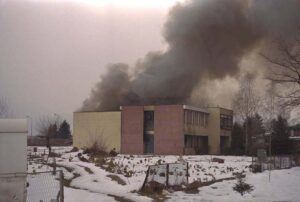Maud Beelman
- 1996

Fellowship Title:
- U.S. Foreign Policy in Ex-Yugoslavia
Fellowship Year:
- 1996

The City of Brcko: The Key to Bosnia’s Future
The billboard signs along the roadways of northeastern Bosnia say it all. Superimposed on a map of the country is the outline of a key with “Brcko” on it. The old river city, historically a crossroads between Europe and the East, holds the key to the future of Bosnia. It is, perhaps, the only thing everyone here agrees on. If Sarajevo symbolized Bosnia’s war, Brcko has symbolized its peace: the potential and the problems. What happens there next largely will determine the success or failure of the U.S.-brokered Bosnian peace accord – and whether war returns to the Balkans. A Dutch member of the International Police Task Force in Bosnia talks to Muslim villagers at a NATO barricade erected to keep villagers out of the zone-of-separation and from the Serb territory, where their prewar homes are located. Brcko, the name of the city and surrounding district in northeastern Bosnia, sits on the banks of the Sava River separating Bosnia from Croatia to the north. Thirty miles east is the Drina River border with Yugoslavia. With

Dining with the Devil: America’s ‘Tacit Cooperation’ with Iran in Arming the Bosnians
The directive from the U.S. ambassador to Croatia set off alarm bells at the CIA. Peter Galbraith wanted his station chief to confirm for Croatian intelligence that the United States did not object to Iran establishing an arms pipeline to the Muslim-led government of neighboring Bosnia-Herzegovina. Just days earlier President Clinton had restated official U.S. policy of respecting, though disagreeing with, the international arms embargo on former Yugoslavia. Confused, the station chief asked headquarters if there had been a policy change. The answer came back no. Victor Jackovich, right, the first U.S. ambassador to Bosnia, speaks with Bosnian Army Gen. Jovan Divjak, an ethnic Serb, during a break in the Sarajevo Parliament session in 1994. Jackovich was one of the U.S. officials not told of Washington’s policy change on Iranian arms to Bosnia. So began the most curious chapter in the muddled history of U.S. attempts to end Europe’s worst bloodletting since World War II. Fearing both leaks and objections, senior National Security Council and State Department officials did not tell their CIA and Pentagon
Hear No Evil, See No Evil: Early U.S. Policy in Yugoslavia
Note: This article contained pictures that were copyrighted and could not be published on this Web page. The small group of American diplomats were gathered in the secure room of the U.S. Embassy in Belgrade, debating what was holding Yugoslavia together and what threatened to tear it apart. It was an intellectual exercise that had gone on in U.S. diplomatic, military, and intelligence circles since the 1980 death of Josip Broz, “Tito,” the Communist dictator who battled the Germans in World War II, distanced the Soviets in the Cold War, and kept Europe’s most multiethnic country intact. Beelman01.jpg Photo by AP/Wide World Photos Slovene soldiers flash victory signs in July 1991 in front of tanks captured from the Yugoslav federal army, the JNA, at a checkpoint on the Yugoslav-Austrian border. The fighting in Slovenia, the northern and most western of Yugoslavia’s six republics, lasted less than a month and paled in comparison to the war that erupted later in Croatia and Bosnia. Beelman02.jpgPhoto by AP/Wide World Photos U.S. Secretary of State James Baker III met

Pitfalls of Peace in Bosnia
The woman piled her books and magazines on the grass in front of her apartment building in the Sarajevo suburb and set them alight. In the crazy logic of her world-turned-upside-down, this meant Serb thugs wouldn’t need to torch her apartment, as they had just done next door. The music school in Ilidza, a Serb suburb, burns the day before the official handover on March 12. A few blocks away, a 75-year-old man watched as a neighbor leaned out his top-floor apartment window, tossing water upwards from a plastic basin in a vain attempt to extinguish the building’s burning roof. Aleksandar and his wife had managed to escape, but she was in the hospital, and he stood there, hair, eyebrows and eyelashes singed. Workers move furniture from the city hall building in Ilidza, the most populous of the five Serb suburbs handed over to a Muslim-Croat federation as specified by the Dayton accord. “Fear of Muslims, fear of Serbs, we’re all going to go crazy,” a woman hurrying past shouted, her hands waving wildly in
